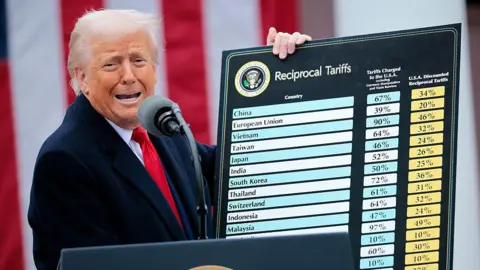Former President Donald Trump has recently commended the recent trade discussions between the United States and China, labeling them as “friendly and constructive.” This statement comes in the wake of a significant shift in the trade dynamics between the two nations. Following the first day of dialogue held in Switzerland, Trump took to social media to express his satisfaction with the negotiations, claiming that a “total reset” in relations had taken place.
The initiate dialogue aims to address the ongoing trade war that has seen both countries impose hefty tariffs on each other’s goods. The United States, under Trump’s administration, has slapped tariffs as high as 145% on certain Chinese imports, prompting retaliatory measures from China, which has responded with levies reaching 125% on select American products. This escalating conflict has put considerable strain on the economic relationships between the two global powers.
The recent talks mark a crucial moment, as they are the first direct negotiations between US and Chinese officials since the implementation of tariffs at the start of the year. Conducted between US Treasury Secretary Scott Bessent and China’s Vice-Premier He Lifeng, discussions took place in Geneva amidst a backdrop of heightened economic tensions. Despite the significant potential for breakthrough, the initial reports following the first day of discussions have provided little detail beyond Trump’s optimistic remarks.
In a follow-up to his social media announcement, Trump underscored the need for openness in the Chinese market for American businesses, indicating that significant progress had been achieved. However, White House Press Secretary Karoline Leavitt emphasized that the US would not reduce its tariffs unilaterally; rather, China’s compliance and adjustments were necessary to achieve a favorable resolution.
Contrasting expectations were also emerging from Beijing, where officials indicated that while they were willing to engage in talks, concessions from the US regarding tariffs would be essential. Bessent highlighted that the focus should be on de-escalation of tensions rather than the pursuit of a sweeping trade agreement. Chinese state media elaborated on the motivations for their engagement with the US, which included external global pressures and appeals from American businesses facing hardships due to the ongoing trade conflict.
The stories of businesses suffering under the burden of tariffs are notable. A case in point is Sorbo Technology, a Chinese exporter reportedly struggling with the tariffs leading to unsold inventory remaining unshipped. Concurrently, the US economy has shown signs of distress, contracting by 0.3% in the first quarter of the year due to the intricate web of trade regulations and tariffs.
The intensifying trade war itself saw new measures last month when Trump declared a universal baseline tariff on all imports, dubbing it “Liberation Day.” This broad yet targeted strategy affected around 60 trading partners, many of whom were marked as “worst offenders,” with China and the European Union prominently featured on this list. Trump’s justification hinged on rectifying what he characterized as years of unfavorable trade practices against the US.
In addition to tariffs on goods, Trump also proposed stark increases on imported steel and aluminum, as well as a 25% levy on cars and car parts. Notably, there has been a recent agreement reached between the US and the UK, which adjusts the anticipated car tariffs from 25% down to 10% for a specified quota of 100,000 vehicles, aligning with the previous year’s export figures.
As efforts to navigate the complexities of international trade continue, all eyes remain on the negotiations unfolding between the United States and China, as both nations weigh the benefits of a mutual agreement against the backdrop of economic pressures and the ramifications of ongoing tariff battles.



